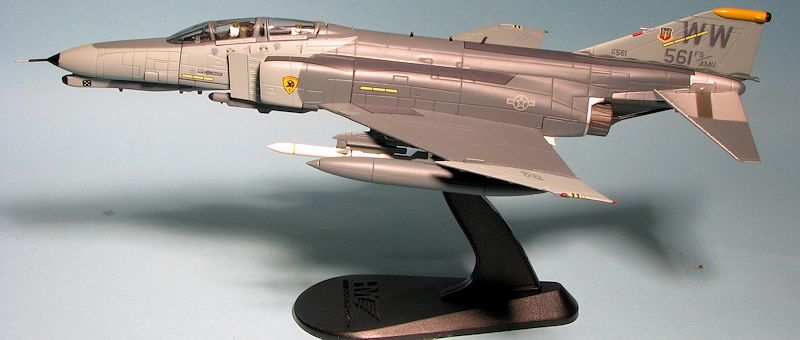
Hobby Master Ltd 1/72 F-4G Wild Weasel
| KIT #: | HA1982 |
| PRICE: | $70-75.00 range |
| DECALS: | Pre-painted |
| REVIEWER: | Scott Van Aken |
| NOTES: | Die-Cast kit |

| HISTORY |
The McDonnell Douglas F-4 Phantom II is a tandem, two-seat, twin-engine, all-weather, long-range supersonic jet interceptor fighter/fighter-bomber originally developed for the United States Navy by McDonnell Aircraft. It first entered service in 1960 with the U.S. Navy. Proving highly adaptable, it was also adopted by the U.S. Marine Corps and the U.S. Air Force, and by the mid-1960s had become a major part of their respective air wings.
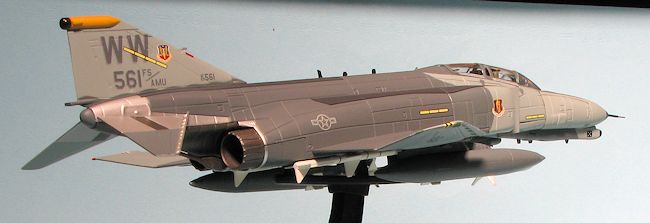 The Phantom is a large fighter with a top speed of over Mach 2.2. It can carry over 18,000 pounds (8,400 kg) of weapons on nine external hardpoints, including air-to-air missiles, air-to-ground missiles, and various bombs. The F-4, like other interceptors of its time, was designed without an internal cannon. Later models incorporated a M61 Vulcan rotary cannon. Beginning in 1959 it set 15 world records for in-flight performance, including an absolute speed record, and an absolute altitude record.
The Phantom is a large fighter with a top speed of over Mach 2.2. It can carry over 18,000 pounds (8,400 kg) of weapons on nine external hardpoints, including air-to-air missiles, air-to-ground missiles, and various bombs. The F-4, like other interceptors of its time, was designed without an internal cannon. Later models incorporated a M61 Vulcan rotary cannon. Beginning in 1959 it set 15 world records for in-flight performance, including an absolute speed record, and an absolute altitude record.
During the Vietnam War the F-4 was used extensively; it served as the principal air superiority fighter for both the Navy and Air Force, and became important in the ground-attack and reconnaissance roles late in the war. The Phantom has the distinction of being the last U.S. fighter flown to attain ace status in the 20th century. During the Vietnam War the USAF had one pilot and two weapon systems officers (WSOs), and the US Navy one pilot and one radar intercept officer (RIO), achieve five aerial kills against other enemy fighter aircraft and become aces in air-to-air combat. The F-4 continued to form a major part of U.S. military air power throughout the 1970s and 1980s, being gradually replaced by more modern aircraft such as the F-15 Eagle and F-16 in the U.S. Air Force; the Grumman F-14 Tomcat and F/A-18 Hornet in the U.S. Navy; and the F/A-18 in the U.S. Marine Corps.
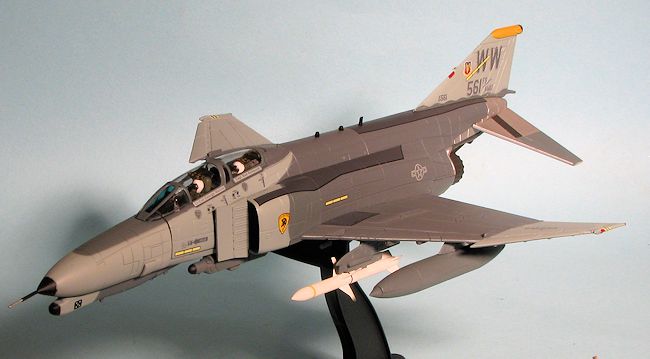 The F-4 Phantom II remained in use by the U.S. in the reconnaissance and Wild Weasel (suppression of enemy air defenses) roles in the 1991 Gulf War, finally leaving service in 1996. It was also the only aircraft used by both U.S. flight demonstration teams: the USAF Thunderbirds (F-4E) and the US Navy Blue Angels (F-4J).[ The F-4 was also operated by the armed forces of 11 other nations. Israeli Phantoms saw extensive combat in several Arab–Israeli conflicts, while Iran used its large fleet of Phantoms in the Iran–Iraq War. Phantoms remain in front line service with several countries, and in use as an unmanned target in the U.S. Air Force. However, it is soon to be retired from the drone force by the QF-16C as the diminishing number of Phantom airframes is used up. Phantom production ran from 1958 to 1981, with a total of 5,195 built, making it the most numerous American supersonic military aircraft.
The F-4 Phantom II remained in use by the U.S. in the reconnaissance and Wild Weasel (suppression of enemy air defenses) roles in the 1991 Gulf War, finally leaving service in 1996. It was also the only aircraft used by both U.S. flight demonstration teams: the USAF Thunderbirds (F-4E) and the US Navy Blue Angels (F-4J).[ The F-4 was also operated by the armed forces of 11 other nations. Israeli Phantoms saw extensive combat in several Arab–Israeli conflicts, while Iran used its large fleet of Phantoms in the Iran–Iraq War. Phantoms remain in front line service with several countries, and in use as an unmanned target in the U.S. Air Force. However, it is soon to be retired from the drone force by the QF-16C as the diminishing number of Phantom airframes is used up. Phantom production ran from 1958 to 1981, with a total of 5,195 built, making it the most numerous American supersonic military aircraft.
As a note, the F-4G aircraft were all converted F-4Es in the 69-xxxx serial sequence and was also the last combat Phantom variant flown by the regular USAF and ANG. Most if not all of them are and will be expended as drones.
| THE KIT |
Last year I was contacted by Hobby Master regarding some information about a specific aircraft, F-4G 69-7561, which just happened to be the boss bird for the 561st TFG in 1992. I was able to supply images that included the names on both sides of the canopy rails, something Hobby Master was quite interested in getting to assure accuracy. They stated that they'd send me a copy of the kit when it was released and a few days ago, a package arrived with this airplane in it.
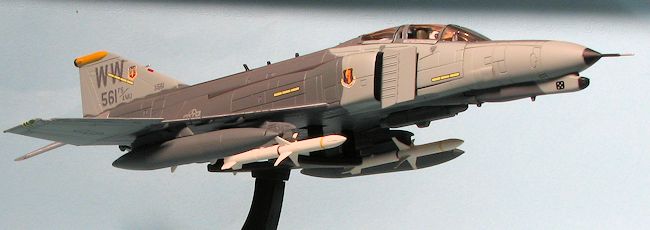 Though it is mostly die-cast, it is a kit in that you need to assemble all the gear bits as well as the ordnance. No instructions are provided so it is assumed you know what goes where.
Though it is mostly die-cast, it is a kit in that you need to assemble all the gear bits as well as the ordnance. No instructions are provided so it is assumed you know what goes where.
As you might expect, the kit has some heft to it since the fuselage and wings are cast metal. All of the other parts of the kit, and that includes the stabs and fin are injected plastic. The kit comes with two pilot figures that you can put in the aircraft, though you'll need to paint their helmets in the lighter grey color to be completely accurate. The rear canopy is hinged while there is a separate forward canopy for the canopy open option.
The kit includes all of the fuel tanks and a full load of ordnance. You get four Sparrows, two HARMS on racks, and two racks full of Sidewinders. Two different jamming pods are also included. Since you can do gear up or down, you'll have spares. I should mention that my sample was missing one of the main gear doors.
the main gear doors.
The painting is really top notch and while there are seams on everything, this is the nature of the beast. One could detail things like painting oleos silver, for instance, but the target audience is generally not concerned about all that. The packaging is first rate as you can see from the image of the kit in the packaging. Hobby Master also packed the box superbly to ensure no damage on the trip from Hong Kong.
| CONSTRUCTION |
I guess this should properly be call assembly as there was none of the usual building sequences normally associated with a standard kit.
 First thing I did was to get all the parts out of their various compartments and bags. As noted, my copy was missing a gear door, which pretty well left off having it with the gear down. This was not an issue as I wanted mine displayed in flight on the stand. So I looked over the bits to see what went where. First step was to remove the pilot canopy section and open the RIO's canopy to insert the crew figures. These are well molded and while they could be spruced up with more painting, I left them alone. They were a snug fit as the legs had to fit on either side of the control sticks. The canopies were closed and I moved to the next step.
First thing I did was to get all the parts out of their various compartments and bags. As noted, my copy was missing a gear door, which pretty well left off having it with the gear down. This was not an issue as I wanted mine displayed in flight on the stand. So I looked over the bits to see what went where. First step was to remove the pilot canopy section and open the RIO's canopy to insert the crew figures. These are well molded and while they could be spruced up with more painting, I left them alone. They were a snug fit as the legs had to fit on either side of the control sticks. The canopies were closed and I moved to the next step.
This was the installation of the gear doors. The nose gear door is a good fit, but the main gear doors have some pretty good size gaps on the back through which you can see the white of the gear wells. Next were weapons. I press fit two Sparrows in the aft bays. There are indentations and you think the parts will just fall out but, for the most part, they won't and the fit is tight. I say for the most part as 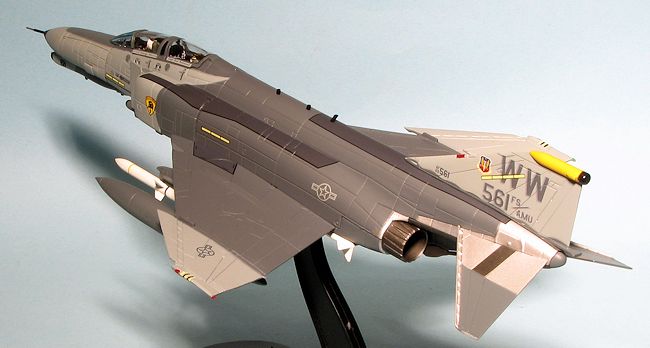 when I went to install the HARMS, the one for the right side would not stay in place. The missile pylons are handed so you need to put them on the proper side. I ended up using a bit of super glue to hold it in.
when I went to install the HARMS, the one for the right side would not stay in place. The missile pylons are handed so you need to put them on the proper side. I ended up using a bit of super glue to hold it in.
The wing tanks were the next items installed. As I was using the display stand, the centerline tank cannot be installed. There are two square plugs on the underside of the wing that have to be removed to allow the display stand to be attached. The ECM pod was pushed in place and the finished model was plugged into the three piece stand.
| CONCLUSIONS |
I have to say that the finished product looks pretty nice. Very much a '3 foot model' because of all the large gaps due to the various bits and pieces that have to be attached, but then, all of the die cast airplanes I've seen are like this. It is just the way it is. Those who want something unavailable in plastic or who want to have a nice collection or wish to buy something nice for a present should seriously look into this sort of thing.
| REFERENCES |
http://en.wikipedia.org/wiki/F-4_Phantom_II
October 2013 Thanks towww.hobbymaster.com.hk for sending this one in.
If you would like your product reviewed fairly and fairly quickly, please contact the editor or see other details in the